2007 ISUZU KB P190 check engine
[x] Cancel search: check enginePage 4374 of 6020
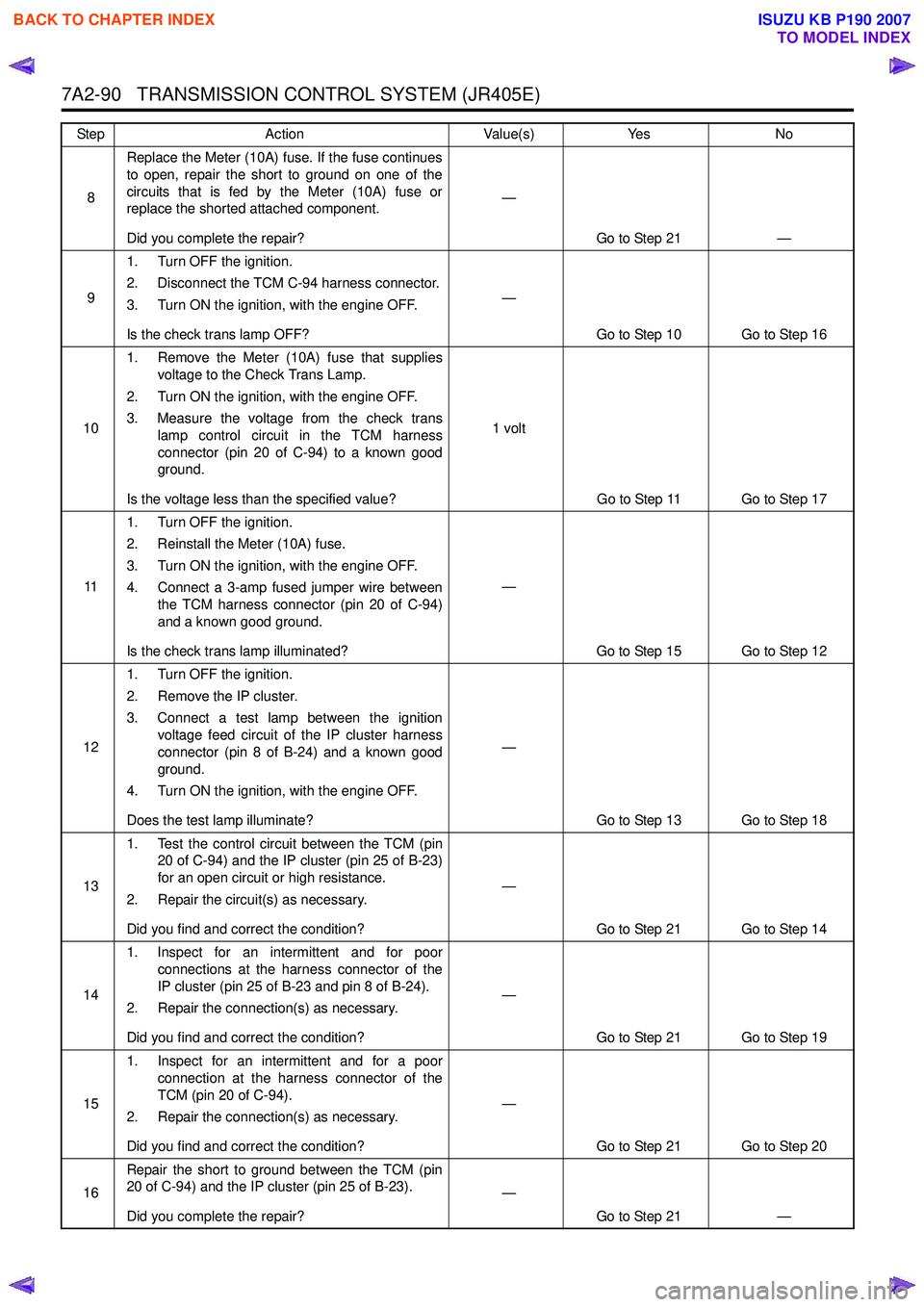
7A2-90 TRANSMISSION CONTROL SYSTEM (JR405E)
8Replace the Meter (10A) fuse. If the fuse continues
to open, repair the short to ground on one of the
circuits that is fed by the Meter (10A) fuse or
replace the shorted attached component.
Did you complete the repair? —
Go to Step 21 —
9 1. Turn OFF the ignition.
2. Disconnect the TCM C-94 harness connector.
3. Turn ON the ignition, with the engine OFF.
Is the check trans lamp OFF? —
Go to Step 10 Go to Step 16
10 1. Remove the Meter (10A) fuse that supplies
voltage to the Check Trans Lamp.
2. Turn ON the ignition, with the engine OFF.
3. Measure the voltage from the check trans lamp control circuit in the TCM harness
connector (pin 20 of C-94) to a known good
ground.
Is the voltage less than the specified value? 1 volt
Go to Step 11 Go to Step 17
11 1. Turn OFF the ignition.
2. Reinstall the Meter (10A) fuse.
3. Turn ON the ignition, with the engine OFF.
4. Connect a 3-amp fused jumper wire between the TCM harness connector (pin 20 of C-94)
and a known good ground.
Is the check trans lamp illuminated? —
Go to Step 15 Go to Step 12
12 1. Turn OFF the ignition.
2. Remove the IP cluster.
3. Connect a test lamp between the ignition voltage feed circuit of the IP cluster harness
connector (pin 8 of B-24) and a known good
ground.
4. Turn ON the ignition, with the engine OFF.
Does the test lamp illuminate? —
Go to Step 13 Go to Step 18
13 1. Test the control circuit between the TCM (pin
20 of C-94) and the IP cluster (pin 25 of B-23)
for an open circuit or high resistance.
2. Repair the circuit(s) as necessary.
Did you find and correct the condition? —
Go to Step 21 Go to Step 14
14 1. Inspect for an intermittent and for poor
connections at the harness connector of the
IP cluster (pin 25 of B-23 and pin 8 of B-24).
2. Repair the connection(s) as necessary.
Did you find and correct the condition? —
Go to Step 21 Go to Step 19
15 1. Inspect for an intermittent and for a poor
connection at the harness connector of the
TCM (pin 20 of C-94).
2. Repair the connection(s) as necessary.
Did you find and correct the condition? —
Go to Step 21 Go to Step 20
16 Repair the short to ground between the TCM (pin
20 of C-94) and the IP cluster (pin 25 of B-23).
Did you complete the repair? —
Go to Step 21 —
Step
Action Value(s)Yes No
BACK TO CHAPTER INDEX
TO MODEL INDEX
ISUZU KB P190 2007
Page 4377 of 6020

TRANSMISSION CONTROL SYSTEM (JR405E) 7A2-93
Intermittent Conditions
ChecksAction
Definition:
The problem is not currently present but is indicated in DTC History.
OR
There is a customer complaint, but the symptom cannot currently be duplicated, if the problem is not DTC related.
Preliminary Checks • Refer to Symptoms - Transmission Controls before starting.
Harness/ Connector Many intermittent open or shorted circuits are affected by harness/ connector
movement that is caused by vibration, engine torque, bumps/ rough pavement, etc.
Test for this type of condition by performing the applicable procedure from the
following list:
• Move related connectors and wiring while monitoring the appropriate scan tool data.
• Move related connectors and wiring with the component commanded ON, and OFF, with the scan tool. Observe the component operation.
• With the engine running, move related connectors and wiring while monitoring engine operation.
If harness or connector movement affects the data displayed, component/ system
operation, or engine operation, inspect and repair the harness/ connections as
necessary.
Electrical Connections or Wiring Poor electrical connections, terminal tension or wiring problems cause most intermittent. To perform the following inspections:
• Poor mating of the connector halves, or terminals improperly seated in the connector body.
• Improperly formed or damaged terminals. Test for poor terminal tension.
• Poor terminal to wire connections including terminals crimped over insulation. This requires removing the terminal from the connector body.
• Corrosion/ water intrusion. Pierced or damaged insulation can allow moisture to enter the wiring. The conductor can corrode inside the insulation, with little
visible evidence. Look for swollen and stiff sections of wire in the suspect
circuits.
• Wires that are broken inside the insulation.
• Harness for pinched, cut or rubbed through wiring.
• Ensure that the wiring does not come in contact with hot exhaust components.
Control Module Power and Grounds
Component Power and Grounds Poor power or ground connections can cause widely varying symptoms.
• Test all control module power supply circuits. Many vehicles have multiple circuits supplying power to the control module. Other components in the system
may have separate power supply circuits that may also need to be tested.
Inspect connections at the module/ component connectors, fuses, and any
intermediate connections between the power source and the module/
component. A test lamp or a DMM may indicate that voltage is present, but
neither tests the ability of the circuit to carry sufficient current. Ensure that the
circuit can carry the current necessary to operate the component.
• Test all control module ground and system ground circuits. The control module may have multiple ground circuits. Other components in the system may have
separate grounds that may also need to be tested. Inspect grounds for clean
and tight connections at the grounding point. Inspect the connections at the
component and in splice packs, where applicable. Ensure that the circuit can
carry the current necessary to operate the component.
BACK TO CHAPTER INDEX
TO MODEL INDEX
ISUZU KB P190 2007
Page 4378 of 6020
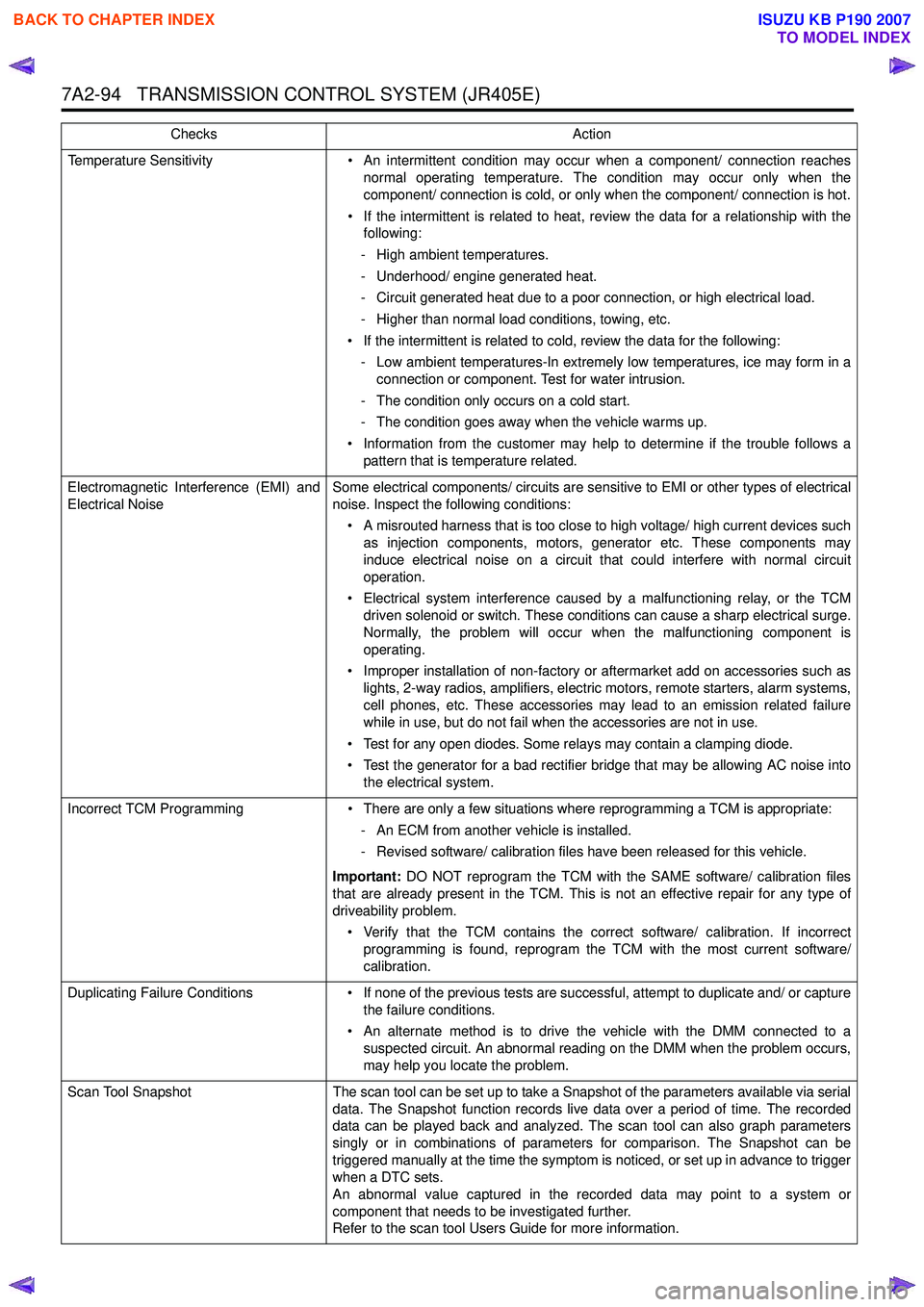
7A2-94 TRANSMISSION CONTROL SYSTEM (JR405E)
Temperature Sensitivity• An intermittent condition may occur when a component/ connection reaches
normal operating temperature. The condition may occur only when the
component/ connection is cold, or only when the component/ connection is hot.
• If the intermittent is related to heat, review the data for a relationship with the following:
- High ambient temperatures.
- Underhood/ engine generated heat.
- Circuit generated heat due to a poor connection, or high electrical load.
- Higher than normal load conditions, towing, etc.
• If the intermittent is related to cold, review the data for the following: - Low ambient temperatures-In extremely low temperatures, ice may form in a connection or component. Test for water intrusion.
- The condition only occurs on a cold start.
- The condition goes away when the vehicle warms up.
• Information from the customer may help to determine if the trouble follows a pattern that is temperature related.
Electromagnetic Interference (EMI) and
Electrical Noise Some electrical components/ circuits are sensitive to EMI or other types of electrical
noise. Inspect the following conditions:
• A misrouted harness that is too close to high voltage/ high current devices such as injection components, motors, generator etc. These components may
induce electrical noise on a circuit that could interfere with normal circuit
operation.
• Electrical system interference caused by a malfunctioning relay, or the TCM driven solenoid or switch. These conditions can cause a sharp electrical surge.
Normally, the problem will occur when the malfunctioning component is
operating.
• Improper installation of non-factory or aftermarket add on accessories such as lights, 2-way radios, amplifiers, electric motors, remote starters, alarm systems,
cell phones, etc. These accessories may lead to an emission related failure
while in use, but do not fail when the accessories are not in use.
• Test for any open diodes. Some relays may contain a clamping diode.
• Test the generator for a bad rectifier bridge that may be allowing AC noise into the electrical system.
Incorrect TCM Programming • There are only a few situations where reprogramming a TCM is appropriate:
- An ECM from another vehicle is installed.
- Revised software/ calibration files have been released for this vehicle.
Important: DO NOT reprogram the TCM with the SAME software/ calibration files
that are already present in the TCM. This is not an effective repair for any type of
driveability problem.
• Verify that the TCM contains the correct software/ calibration. If incorrect programming is found, reprogram the TCM with the most current software/
calibration.
Duplicating Failure Conditions • If none of the previous tests are successful, attempt to duplicate and/ or capture
the failure conditions.
• An alternate method is to drive the vehicle with the DMM connected to a suspected circuit. An abnormal reading on the DMM when the problem occurs,
may help you locate the problem.
Scan Tool Snapshot The scan tool can be set up to take a Snapshot of the parameters available via serial
data. The Snapshot function records live data over a period of time. The recorded
data can be played back and analyzed. The scan tool can also graph parameters
singly or in combinations of parameters for comparison. The Snapshot can be
triggered manually at the time the symptom is noticed, or set up in advance to trigger
when a DTC sets.
An abnormal value captured in the recorded data may point to a system or
component that needs to be investigated further.
Refer to the scan tool Users Guide for more information.
Checks
Action
BACK TO CHAPTER INDEX
TO MODEL INDEX
ISUZU KB P190 2007
Page 4386 of 6020
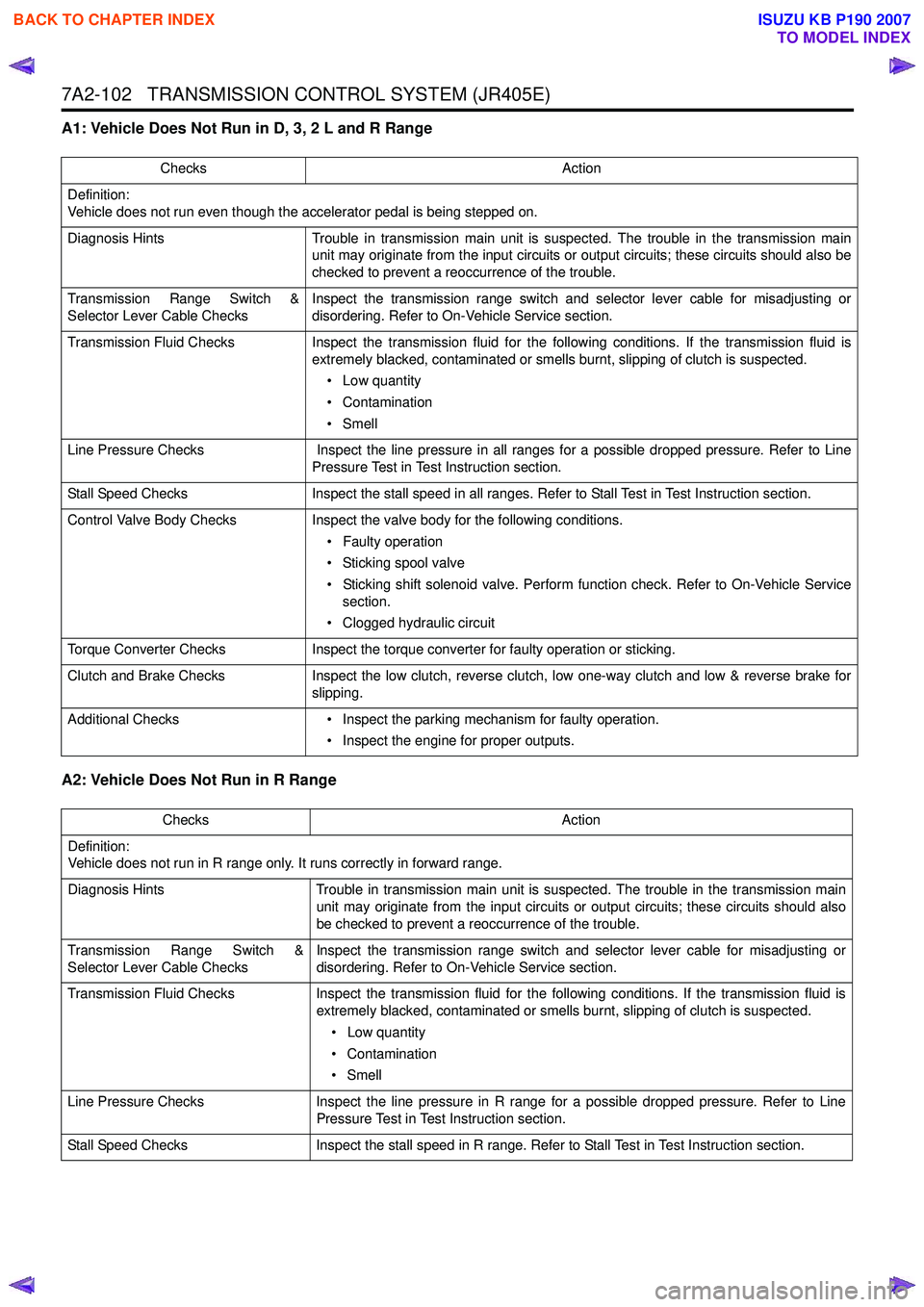
7A2-102 TRANSMISSION CONTROL SYSTEM (JR405E)
A1: Vehicle Does Not Run in D, 3, 2 L and R Range
A2: Vehicle Does Not Run in R Range
ChecksAction
Definition:
Vehicle does not run even though the accelerator pedal is being stepped on.
Diagnosis Hints Trouble in transmission main unit is suspected. The trouble in the transmission main
unit may originate from the input circuits or output circuits; these circuits should also be
checked to prevent a reoccurrence of the trouble.
Transmission Range Switch &
Selector Lever Cable Checks Inspect the transmission range switch and selector lever cable for misadjusting or
disordering. Refer to On-Vehicle Service section.
Transmission Fluid Checks Inspect the transmission fluid for the following conditions. If the transmission fluid is
extremely blacked, contaminated or smells burnt, slipping of clutch is suspected.
• Low quantity
• Contamination
•Smell
Line Pressure Checks Inspect the line pressure in all ranges for a possible dropped pressure. Refer to Line
Pressure Test in Test Instruction section.
Stall Speed Checks Inspect the stall speed in all ranges. Refer to Stall Test in Test Instruction section.
Control Valve Body Checks Inspect the valve body for the following conditions.
• Faulty operation
• Sticking spool valve
• Sticking shift solenoid valve. Perform function check. Refer to On-Vehicle Service section.
• Clogged hydraulic circuit
Torque Converter Checks Inspect the torque converter for faulty operation or sticking.
Clutch and Brake Checks Inspect the low clutch, reverse clutch, low one-way clutch and low & reverse brake for
slipping.
Additional Checks • Inspect the parking mechanism for faulty operation.
• Inspect the engine for proper outputs.
Checks Action
Definition:
Vehicle does not run in R range only. It runs correctly in forward range.
Diagnosis Hints Trouble in transmission main unit is suspected. The trouble in the transmission main
unit may originate from the input circuits or output circuits; these circuits should also
be checked to prevent a reoccurrence of the trouble.
Transmission Range Switch &
Selector Lever Cable Checks Inspect the transmission range switch and selector lever cable for misadjusting or
disordering. Refer to On-Vehicle Service section.
Transmission Fluid Checks Inspect the transmission fluid for the following conditions. If the transmission fluid is
extremely blacked, contaminated or smells burnt, slipping of clutch is suspected.
• Low quantity
• Contamination
•Smell
Line Pressure Checks Inspect the line pressure in R range for a possible dropped pressure. Refer to Line
Pressure Test in Test Instruction section.
Stall Speed Checks Inspect the stall speed in R range. Refer to Stall Test in Test Instruction section.
BACK TO CHAPTER INDEX
TO MODEL INDEX
ISUZU KB P190 2007
Page 4387 of 6020
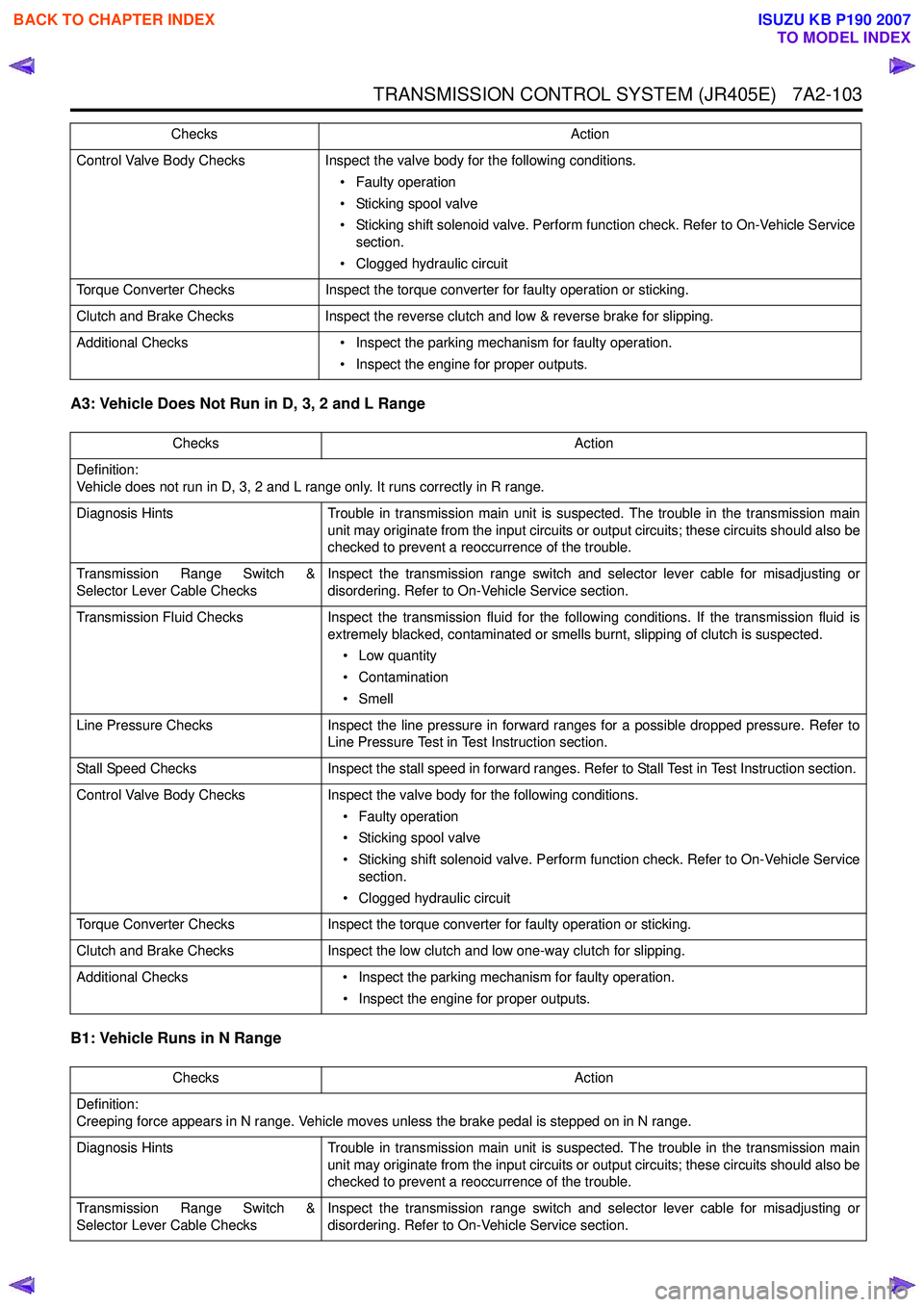
TRANSMISSION CONTROL SYSTEM (JR405E) 7A2-103
A3: Vehicle Does Not Run in D, 3, 2 and L Range
B1: Vehicle Runs in N Range
Control Valve Body Checks Inspect the valve body for the following conditions.
• Faulty operation
• Sticking spool valve
• Sticking shift solenoid valve. Perform function check. Refer to On-Vehicle Service section.
• Clogged hydraulic circuit
Torque Converter Checks Inspect the torque converter for faulty operation or sticking.
Clutch and Brake Checks Inspect the reverse clutch and low & reverse brake for slipping.
Additional Checks • Inspect the parking mechanism for faulty operation.
• Inspect the engine for proper outputs.
Checks
Action
Checks Action
Definition:
Vehicle does not run in D, 3, 2 and L range only. It runs correctly in R range.
Diagnosis Hints Trouble in transmission main unit is suspected. The trouble in the transmission main
unit may originate from the input circuits or output circuits; these circuits should also be
checked to prevent a reoccurrence of the trouble.
Transmission Range Switch &
Selector Lever Cable Checks Inspect the transmission range switch and selector lever cable for misadjusting or
disordering. Refer to On-Vehicle Service section.
Transmission Fluid Checks Inspect the transmission fluid for the following conditions. If the transmission fluid is
extremely blacked, contaminated or smells burnt, slipping of clutch is suspected.
• Low quantity
• Contamination
•Smell
Line Pressure Checks Inspect the line pressure in forward ranges for a possible dropped pressure. Refer to
Line Pressure Test in Test Instruction section.
Stall Speed Checks Inspect the stall speed in forward ranges. Refer to Stall Test in Test Instruction section.
Control Valve Body Checks Inspect the valve body for the following conditions.
• Faulty operation
• Sticking spool valve
• Sticking shift solenoid valve. Perform function check. Refer to On-Vehicle Service section.
• Clogged hydraulic circuit
Torque Converter Checks Inspect the torque converter for faulty operation or sticking.
Clutch and Brake Checks Inspect the low clutch and low one-way clutch for slipping.
Additional Checks • Inspect the parking mechanism for faulty operation.
• Inspect the engine for proper outputs.
Checks Action
Definition:
Creeping force appears in N range. Vehicle moves unless the brake pedal is stepped on in N range.
Diagnosis Hints Trouble in transmission main unit is suspected. The trouble in the transmission main
unit may originate from the input circuits or output circuits; these circuits should also be
checked to prevent a reoccurrence of the trouble.
Transmission Range Switch &
Selector Lever Cable Checks Inspect the transmission range switch and selector lever cable for misadjusting or
disordering. Refer to On-Vehicle Service section.
BACK TO CHAPTER INDEX
TO MODEL INDEX
ISUZU KB P190 2007
Page 4388 of 6020
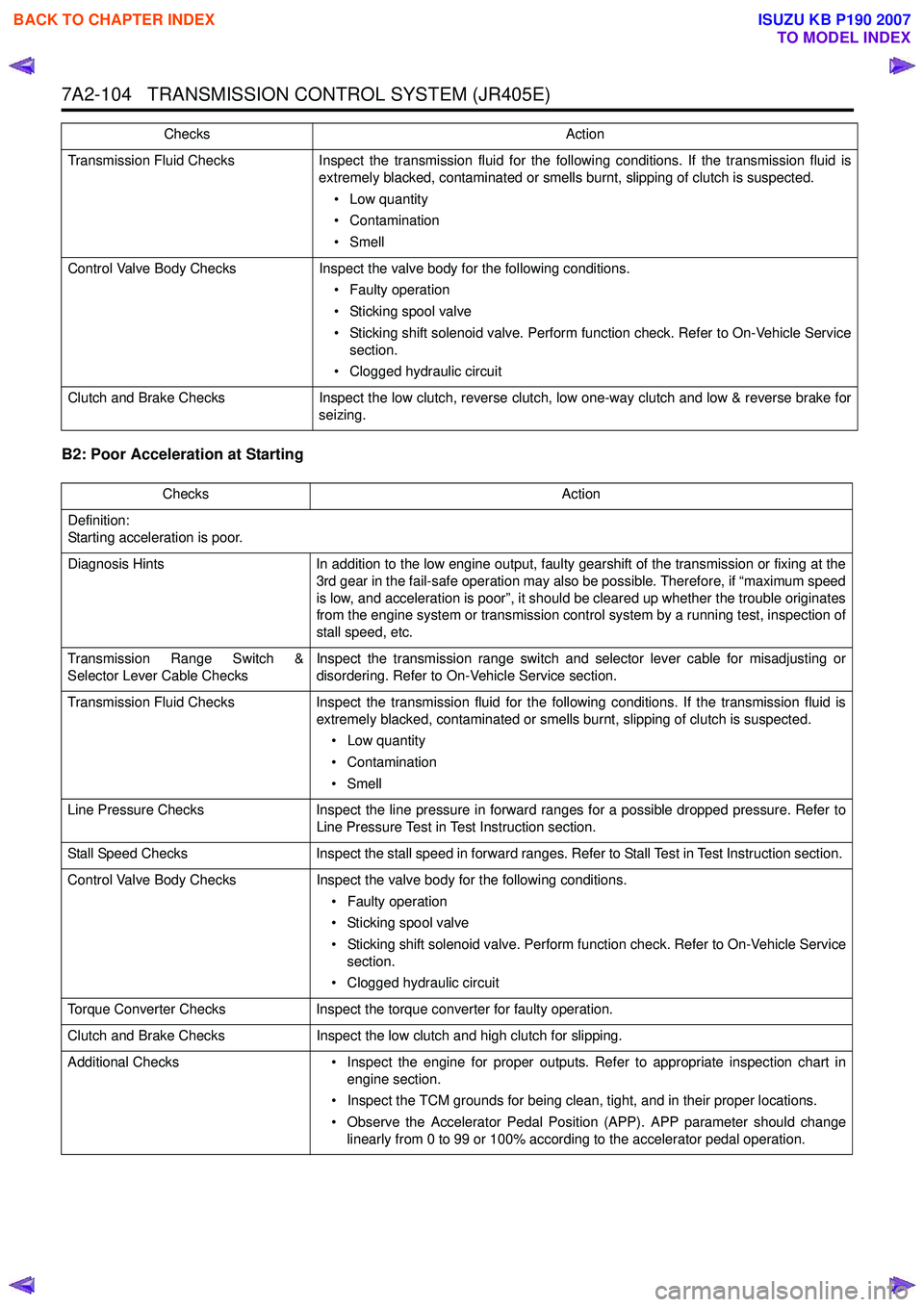
7A2-104 TRANSMISSION CONTROL SYSTEM (JR405E)
B2: Poor Acceleration at Starting
Transmission Fluid ChecksInspect the transmission fluid for the following conditions. If the transmission fluid is
extremely blacked, contaminated or smells burnt, slipping of clutch is suspected.
• Low quantity
• Contamination
•Smell
Control Valve Body Checks Inspect the valve body for the following conditions.
• Faulty operation
• Sticking spool valve
• Sticking shift solenoid valve. Perform function check. Refer to On-Vehicle Service section.
• Clogged hydraulic circuit
Clutch and Brake Checks Inspect the low clutch, reverse clutch, low one-way clutch and low & reverse brake for
seizing.
Checks
Action
ChecksAction
Definition:
Starting acceleration is poor.
Diagnosis Hints In addition to the low engine output, faulty gearshift of the transmission or fixing at the
3rd gear in the fail-safe operation may also be possible. Therefore, if “maximum speed
is low, and acceleration is poor”, it should be cleared up whether the trouble originates
from the engine system or transmission control system by a running test, inspection of
stall speed, etc.
Transmission Range Switch &
Selector Lever Cable Checks Inspect the transmission range switch and selector lever cable for misadjusting or
disordering. Refer to On-Vehicle Service section.
Transmission Fluid Checks Inspect the transmission fluid for the following conditions. If the transmission fluid is
extremely blacked, contaminated or smells burnt, slipping of clutch is suspected.
• Low quantity
• Contamination
•Smell
Line Pressure Checks Inspect the line pressure in forward ranges for a possible dropped pressure. Refer to
Line Pressure Test in Test Instruction section.
Stall Speed Checks Inspect the stall speed in forward ranges. Refer to Stall Test in Test Instruction section.
Control Valve Body Checks Inspect the valve body for the following conditions.
• Faulty operation
• Sticking spool valve
• Sticking shift solenoid valve. Perform function check. Refer to On-Vehicle Service section.
• Clogged hydraulic circuit
Torque Converter Checks Inspect the torque converter for faulty operation.
Clutch and Brake Checks Inspect the low clutch and high clutch for slipping.
Additional Checks • Inspect the engine for proper outputs. Refer to appropriate inspection chart in
engine section.
• Inspect the TCM grounds for being clean, tight, and in their proper locations.
• Observe the Accelerator Pedal Position (APP). APP parameter should change linearly from 0 to 99 or 100% according to the accelerator pedal operation.
BACK TO CHAPTER INDEX
TO MODEL INDEX
ISUZU KB P190 2007
Page 4389 of 6020
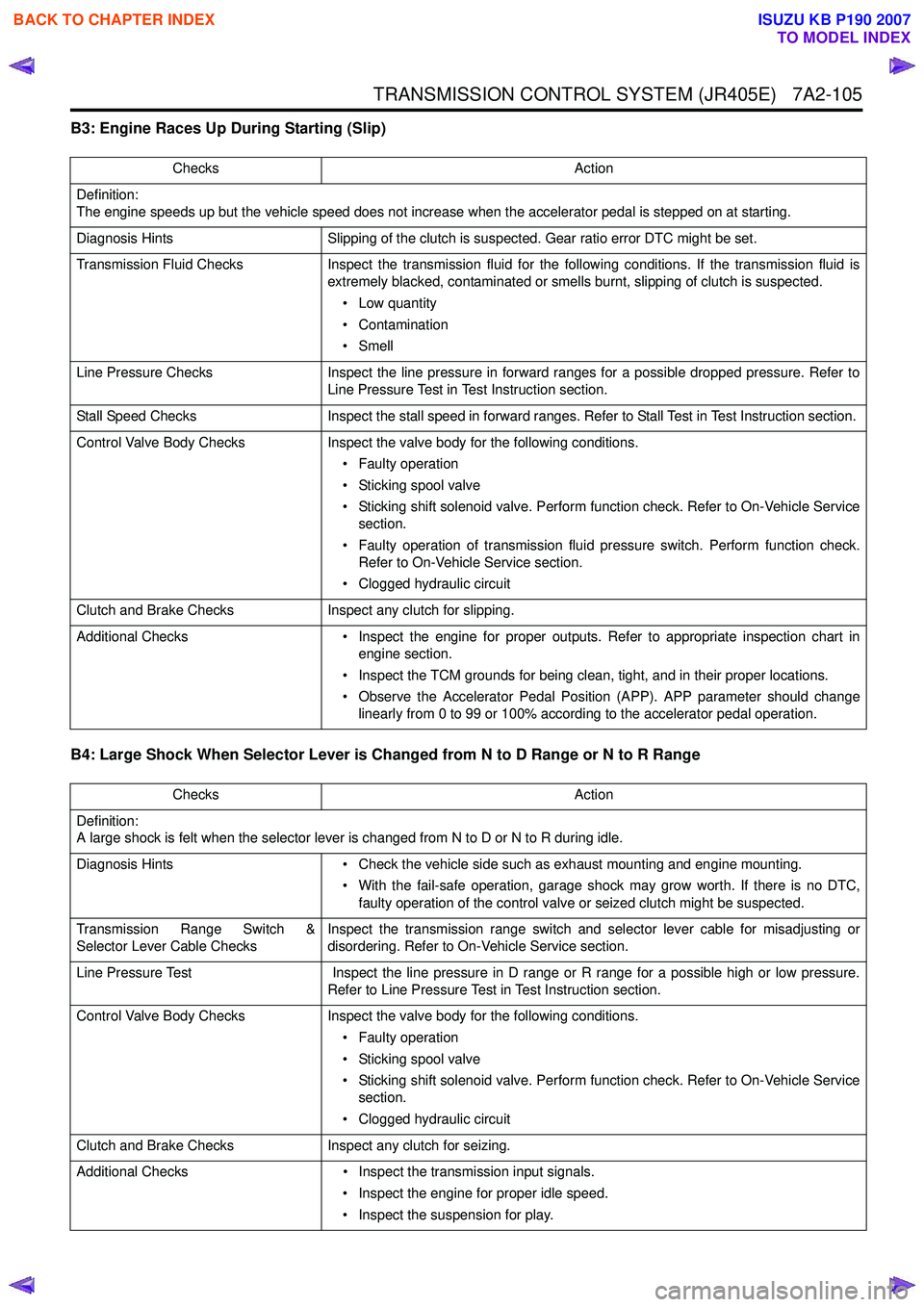
TRANSMISSION CONTROL SYSTEM (JR405E) 7A2-105
B3: Engine Races Up During Starting (Slip)
B4: Large Shock When Selector Lever is Changed from N to D Range or N to R Range
Checks Action
Definition:
The engine speeds up but the vehicle speed does not increase when the accelerator pedal is stepped on at starting.
Diagnosis Hints Slipping of the clutch is suspected. Gear ratio error DTC might be set.
Transmission Fluid Checks Inspect the transmission fluid for the following conditions. If the transmission fluid is
extremely blacked, contaminated or smells burnt, slipping of clutch is suspected.
• Low quantity
• Contamination
•Smell
Line Pressure Checks Inspect the line pressure in forward ranges for a possible dropped pressure. Refer to
Line Pressure Test in Test Instruction section.
Stall Speed Checks Inspect the stall speed in forward ranges. Refer to Stall Test in Test Instruction section.
Control Valve Body Checks Inspect the valve body for the following conditions.
• Faulty operation
• Sticking spool valve
• Sticking shift solenoid valve. Perform function check. Refer to On-Vehicle Service section.
• Faulty operation of transmission fluid pressure switch. Perform function check. Refer to On-Vehicle Service section.
• Clogged hydraulic circuit
Clutch and Brake Checks Inspect any clutch for slipping.
Additional Checks • Inspect the engine for proper outputs. Refer to appropriate inspection chart in
engine section.
• Inspect the TCM grounds for being clean, tight, and in their proper locations.
• Observe the Accelerator Pedal Position (APP). APP parameter should change linearly from 0 to 99 or 100% according to the accelerator pedal operation.
Checks Action
Definition:
A large shock is felt when the selector lever is changed from N to D or N to R during idle.
Diagnosis Hints • Check the vehicle side such as exhaust mounting and engine mounting.
• With the fail-safe operation, garage shock may grow worth. If there is no DTC, faulty operation of the control valve or seized clutch might be suspected.
Transmission Range Switch &
Selector Lever Cable Checks Inspect the transmission range switch and selector lever cable for misadjusting or
disordering. Refer to On-Vehicle Service section.
Line Pressure Test Inspect the line pressure in D range or R range for a possible high or low pressure.
Refer to Line Pressure Test in Test Instruction section.
Control Valve Body Checks Inspect the valve body for the following conditions.
• Faulty operation
• Sticking spool valve
• Sticking shift solenoid valve. Perform function check. Refer to On-Vehicle Service section.
• Clogged hydraulic circuit
Clutch and Brake Checks Inspect any clutch for seizing.
Additional Checks • Inspect the transmission input signals.
• Inspect the engine for proper idle speed.
• Inspect the suspension for play.
BACK TO CHAPTER INDEX
TO MODEL INDEX
ISUZU KB P190 2007
Page 4390 of 6020
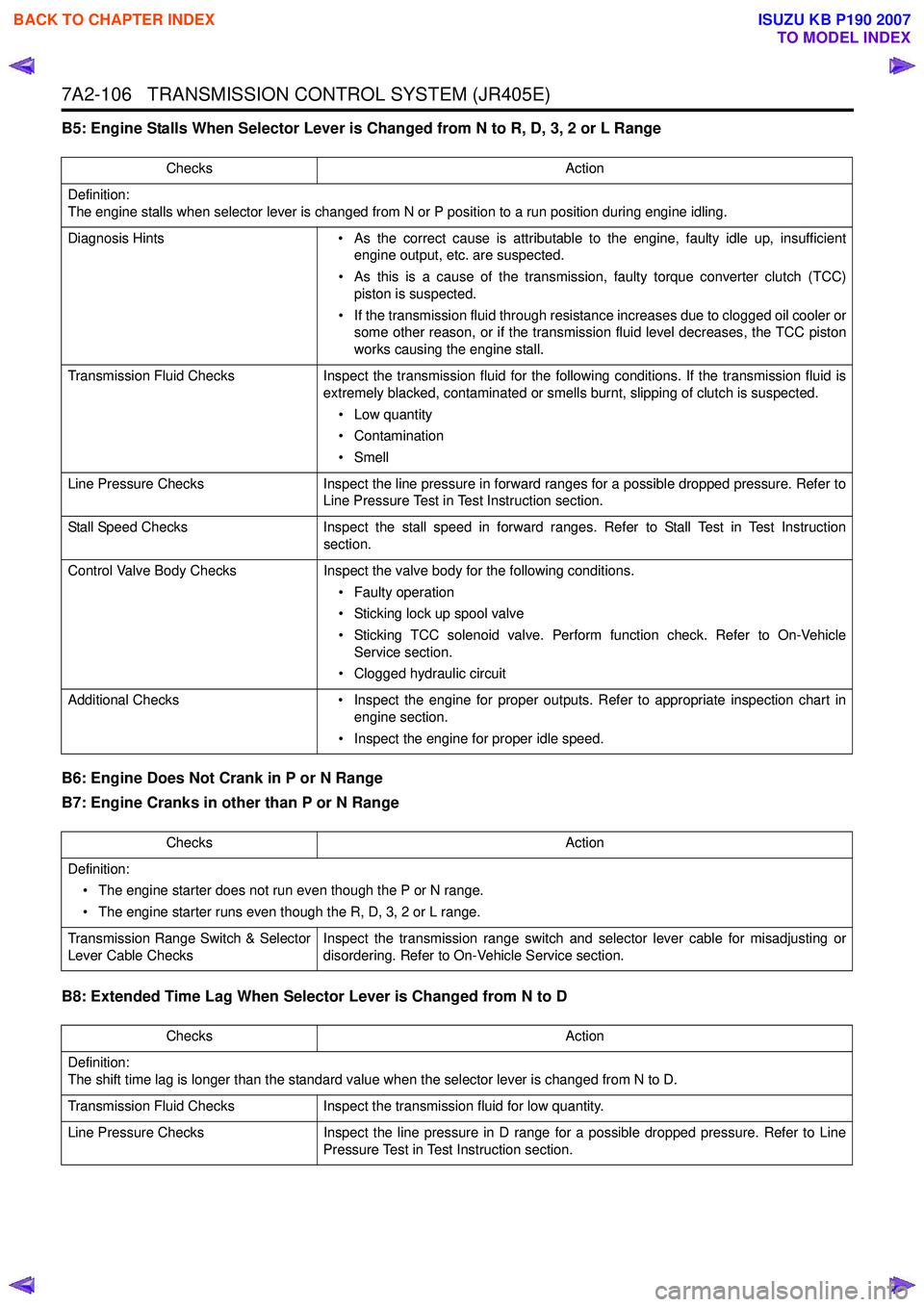
7A2-106 TRANSMISSION CONTROL SYSTEM (JR405E)
B5: Engine Stalls When Selector Lever is Changed from N to R, D, 3, 2 or L Range
B6: Engine Does Not Crank in P or N Range
B7: Engine Cranks in other than P or N Range
B8: Extended Time Lag When Selector Lever is Changed from N to D
Checks Action
Definition:
The engine stalls when selector lever is changed from N or P position to a run position during engine idling.
Diagnosis Hints • As the correct cause is attributable to the engine, faulty idle up, insufficient
engine output, etc. are suspected.
• As this is a cause of the transmission, faulty torque converter clutch (TCC) piston is suspected.
• If the transmission fluid through resistance increases due to clogged oil cooler or some other reason, or if the transmission fluid level decreases, the TCC piston
works causing the engine stall.
Transmission Fluid Checks Inspect the transmission fluid for the following conditions. If the transmission fluid is
extremely blacked, contaminated or smells burnt, slipping of clutch is suspected.
• Low quantity
• Contamination
• Smell
Line Pressure Checks Inspect the line pressure in forward ranges for a possible dropped pressure. Refer to
Line Pressure Test in Test Instruction section.
Stall Speed Checks Inspect the stall speed in forward ranges. Refer to Stall Test in Test Instruction
section.
Control Valve Body Checks Inspect the valve body for the following conditions.
• Faulty operation
• Sticking lock up spool valve
• Sticking TCC solenoid valve. Perform function check. Refer to On-Vehicle Service section.
• Clogged hydraulic circuit
Additional Checks • Inspect the engine for proper outputs. Refer to appropriate inspection chart in
engine section.
• Inspect the engine for proper idle speed.
Checks Action
Definition: • The engine starter does not run even though the P or N range.
• The engine starter runs even though the R, D, 3, 2 or L range.
Transmission Range Switch & Selector
Lever Cable Checks Inspect the transmission range switch and selector lever cable for misadjusting or
disordering. Refer to On-Vehicle Service section.
Checks Action
Definition:
The shift time lag is longer than the standard value when the selector lever is changed from N to D.
Transmission Fluid Checks Inspect the transmission fluid for low quantity.
Line Pressure Checks Inspect the line pressure in D range for a possible dropped pressure. Refer to Line
Pressure Test in Test Instruction section.
BACK TO CHAPTER INDEX
TO MODEL INDEX
ISUZU KB P190 2007